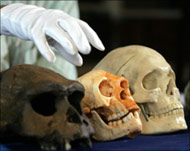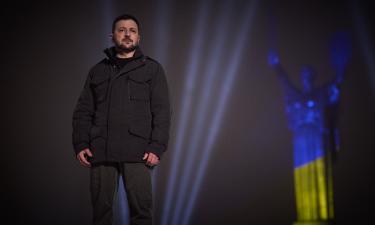Scientists find child fossil from 3.3 million years ago
A 3.3-million-year-old skeleton of a young child curled into a ball no bigger than a cantaloupe - a unique fossil described as "a bright beam of light" on human evolution - was unveiled Wednesday by paleontologists working in the sun-baked badlands of Ethiopia.

The tiny bundle of bones may be the best fossil yet found of the primitive human ancestor Australopithecus afarensis. That is the same species as the superstar fossil dubbed Lucy, an adult female discovered nearby in 1974.
The skeleton, described in the British scientific journal Nature and National Geographic magazine, represents the first juvenile remains of these ancient humanlike creatures, making the fossil the oldest child by far ever found.
"This is something you find once in a lifetime," said Zeresenay Alemseged, of the Max Planck Institute for Evolutionary Anthropology in Leipzig, Germany, an Ethiopian paleoanthropologist who led the team that discovered it, reports Contra Costa Times.
According to London Free Press, the find includes a complete skull, including an impression of the brain and the lower jaw, all the vertebrae from the neck to just below the torso, all the ribs, both shoulder blades and both collarbones, the right elbow and part of a hand, both knees and much of both shin and thigh bones, Spoor said.
One foot is almost complete, providing the first time scientists have found an afarensis foot with the bones still positioned as they were in life.
Spoor, professor of evolutionary anatomy at University College London, describes the fossil in today's issue of the journal Nature along with other scientists.
The skeleton was found in 2000 in northeastern Ethiopia. Scientists have spent five years removing the bones from sandstone, and the job will take years more to complete.
Zeresenay Alemseged, at the Max Planck Institute for Evolutionary Anthropology in Leipzig, who led the study, said: "There's no other fossil as complete as this one that is older than the neanderthals. When you look at her, you can tell what she looked like. She has a face and that in my opinion is a huge addition to our understanding of what our human ancestors looked like, not only 3.3m years ago, but when they were three years old."
"The region would have attracted animals dependent on permanent sources of water, such as early relatives of crocodiles and hippos," said Jonathan Wynn, of the University of South Florida, a co-author of the report. "The first thing that strikes you about the skeleton is how tiny it is. You want to cradle it." Chris Stringer, an expert in human evolution at the Natural History Museum in London, said: "This is a very special find. It's not until we come to intentional burials by Neanderthals and modern humans in the last 100,000 years that we otherwise find such well-preserved infant remains, because of their fragility," informs Reuters.
Subscribe to Pravda.Ru Telegram channel, Facebook, RSS!





